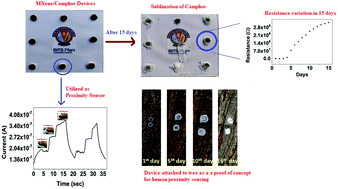Sublimation of MXene/camphor device: a study on self – destructive dry transiency†
Abstract
Recently, transient electronics have come into the limelight on account of their programmable destruction for various exciting biomedical and secure hardware electronics applications, which are impossible to achieve with conventional electronics. Most of the degradation or the destruction process of transient electronic devices relies on wet chemistry, i.e., their dissolution in aqueous and non-aqueous solutions. The triggering of the wet chemistry depends on the availability of the solutions, which is a severe limitation for devices that need to be operated where water/solution availability is scarce. These limitations motivate the exploration a new type of transience materials, where they naturally degrade into the environment without the need for wet chemistry. For the first time, this work demonstrates the fabrication of MXene (Ti3C2Tx) on a camphor-based device where the camphor (sublimable material) acts as a supporting substrate. The fabricated MXene/camphor device under ambient conditions results in the mechanical fragmentation of the supporting substrate and causes the disintegration of the active material, which leads to the degradation of the device within 15 days. The fabricated device was utilized as a human proximity sensor and as a proof of concept deployed on a tree to demonstrate the disintegration of devices in 15 days. The sensor may find potential applications in defence and strategic missions, among others.



 Please wait while we load your content...
Please wait while we load your content...